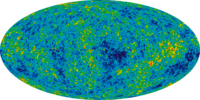
Photo from wikipedia
We study the quenching of star formation as a function of redshift, environment and stellar mass in the galaxy formation simulations of Henriques et al. (2015), which implement an updated… Click to show full abstract
We study the quenching of star formation as a function of redshift, environment and stellar mass in the galaxy formation simulations of Henriques et al. (2015), which implement an updated version of the Munich semi-analytic model (L-GALAXIES) on the two Millennium Simulations after scaling to a Planck cosmology. In this model massive galaxies are quenched by AGN feedback depending on both black hole and hot gas mass, and hence indirectly on stellar mass. In addition, satellite galaxies of any mass can be quenched by ram-pressure or tidal stripping of gas and through the suppression of gaseous infall. This combination of processes produces quenching efficiencies which depend on stellar mass, host halo mass, environment density, distance to group centre and group central galaxy properties in ways which agree qualitatively with observation. Some discrepancies remain in dense regions and close to group centres, where quenching still seems too efficient. In addition, although the mean stellar age of massive galaxies agrees with observation, the assumed AGN feedback model allows too much ongoing star formation at late times. The fact that both AGN feedback and environmental effects are stronger in higher density environments leads to a correlation between the quenching of central and satellite galaxies which roughly reproduces observed conformity trends inside haloes.
Journal Title: Monthly Notices of the Royal Astronomical Society
Year Published: 2017
Link to full text (if available)
Share on Social Media: Sign Up to like & get
recommendations!